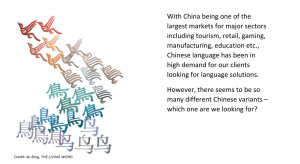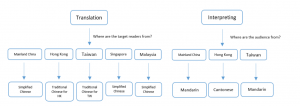Understanding Chinese Variants

Understand Chinese variants and how they impact your language solutions

Written or Spoken?
First of all, is the service needed for written translation or interpreting? Prime Production has many clients requesting translations in Mandarin or Cantonese. Actually, Cantonese and Mandarin are the spoken Chinese languages, and Simplified and Traditional Chinese are the written Chinese scripts.
For written translation and editing, the target language is always Simplified or Traditional Chinese depending on the market; for interpreting and voice-overs, the target language is usually Mandarin or Cantonese.
Simplified or Traditional?
What’s the difference between Simplified and Traditional Chinese and why the change? Back in 1949, the People’s Republic of China started the switch to Simplified Chinese to encourage the increase of literacy. As you can see from the examples below, Traditional characters are complicated and have more strokes, while simplified characters are, as the name suggests, simpler with fewer strokes. Simplified Chinese is now used in Mainland China, Malaysia and Singapore whilst Traditional Chinese is used in Hong Kong and Taiwan.

Mandarin or Cantonese?
People in Mainland China speak Mandarin and write in Simplified Chinese, whilst people in other regions and countries speak Cantonese and write Traditional Chinese?
Yes and No.
Mandarin (普通话) and Cantonese (粤语or 广东话) are the largest Chinese dialects. Mandarin is the official language of Mainland China and Taiwan, although many other dialects are used as local people’s daily language. For example, Cantonese is primarily used in Guangdong and Guangxi Province and Hakka and Hokkien are widely spoken in Fujian Province and Taiwan. Cantonese is the lingua franca of Hong Kong and there are slight differences between the pronunciation used in Hong Kong Cantonese and that of the Cantonese spoken in the neighbouring Guangdong Province.
What does it mean when it comes to translation or interpreting projects?
We’ve created a flowchart to decide the appropriate language for Chinese translation or interpreting projects. We take Singapore and Malaysia off for interpreting because it’s rarely required.

Traditional Chinese for Hong Kong vs. Traditional Chinese for Taiwan
So people from Hong Kong and Taiwan speak differently but write the same? Not quite. The traditional Chinese used in Hong Kong and Taiwan have evolved in their own ways and developed their own terms, expressions and even characters! Here we list some examples:
|
English |
Simplified Chinese |
Traditional Chinese for HK |
Traditional Chinese for TW |
|
inside |
里面 |
裏面 |
裡面 |
|
software |
软件 |
軟件 |
軟體 |
|
bus |
公共汽车 |
巴士 |
公車 |
|
sandwich |
三明治 |
三文治 |
三明治 |
Despite all the differences, people usually can understand the text from other regions/countries without any problem, but that won’t make them as comfortable as reading the text in their own variant style. Therefore, if your target readers are from different regions, we strongly recommend having your document translated into Simplified Chinese, Traditional Chinese for Hong Kong and Traditional Chinese for Taiwan, especially for text which requires critical cultural awareness, for example marketing and market research questionnaires.
Prime Production provides a wide range of services to international organisations and leading companies in the industry. To find out how we can help with language challenges for the Chinese speaking market, don’t hesitate to get in touch.

Leave a Reply